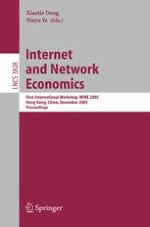WINE 2005, the First Workshop on Internet and Network Economics (WINE 2005), took place in Hong Kong, China, December 15-17, 2005. The symposium aims to provide a forum for researchers working in Internet and Network Economic algorithms from all over the world. The final count of electronic submissions was 372, of which 108 were accepted. It consists of the main program of 31 papers, of which the submitter email accounts are: 10 from edu (USA) accounts, 3 from hk (Hong Kong), 2 each from il (Isreal), cn (China), ch (Switzerland), de (Germany), jp (Japan), gr (Greece), 1 each from hp. com, sohu. com, pl (Poland), fr (France), ca (Canada), and in (India). In addition, 77 papers from 20 countries or regions and 6 dot. coms were selected for 16 special focus tracks in the areas of Internet and Algorithmic Economics; E-Commerce Protocols; Security; Collaboration, Reputation and Social Networks; Algorithmic Mechanism; Financial Computing; Auction Algorithms; Online Algorithms; Collective Rationality; Pricing Policies; Web Mining Strategies; Network Economics; Coalition Strategies; Internet Protocols; Price Sequence; Equilibrium. We had one best student paper nomination: “Walrasian Equilibrium: Hardness, Approximations and Tracktable Instances” by Ning Chen and Atri Rudra. We would like to thank Andrew Yao for serving the conference as its Chair, with inspiring encouragement and far-sighted leadership. We would like to thank the International Program Committee for spending their valuable time and effort in the review process.
